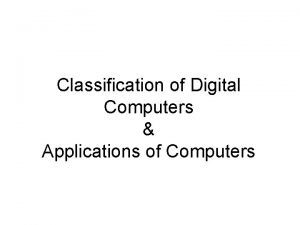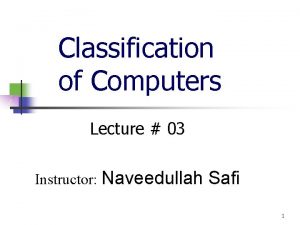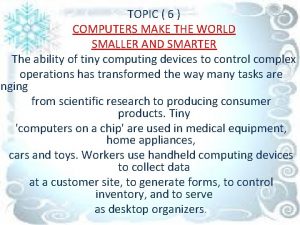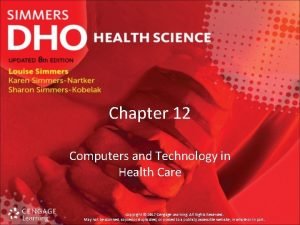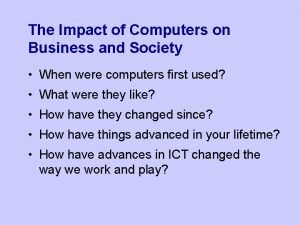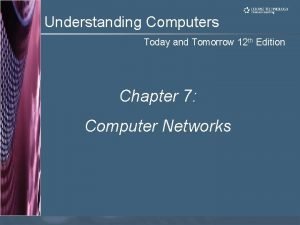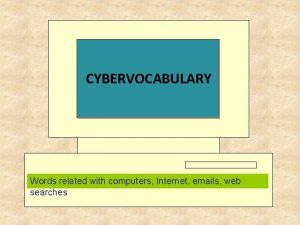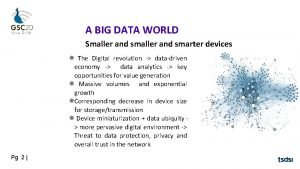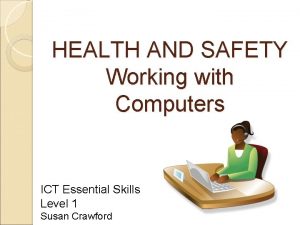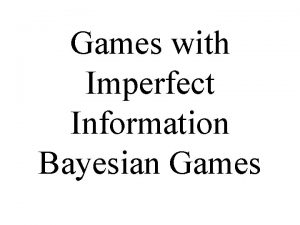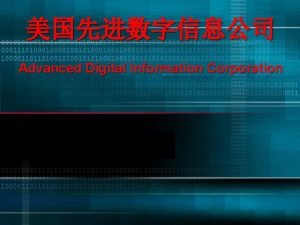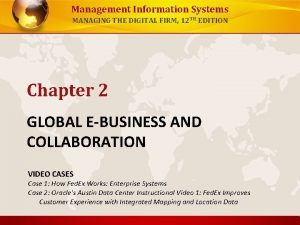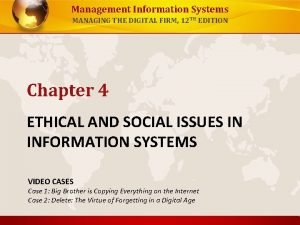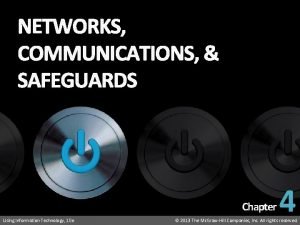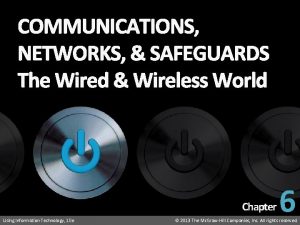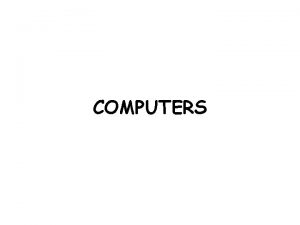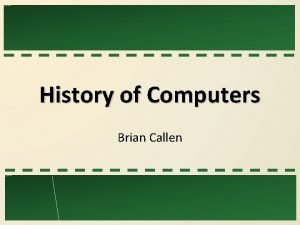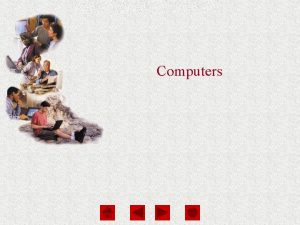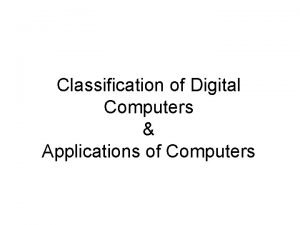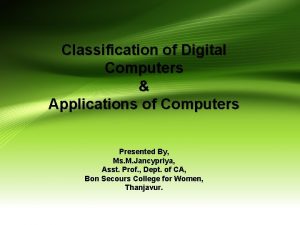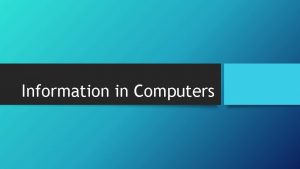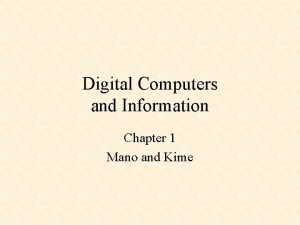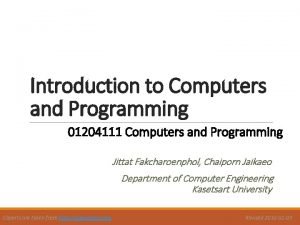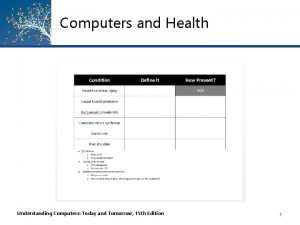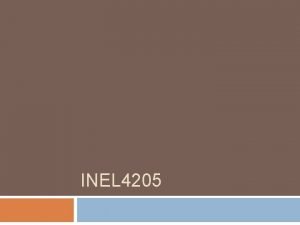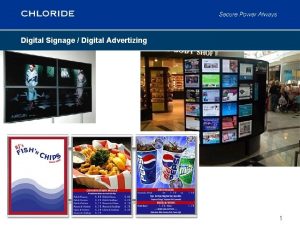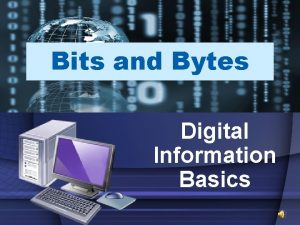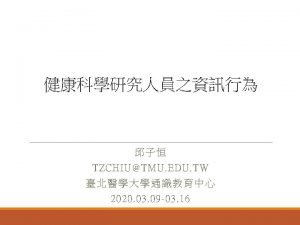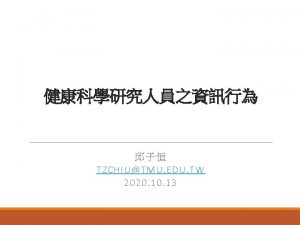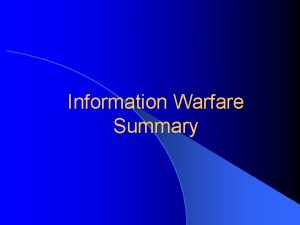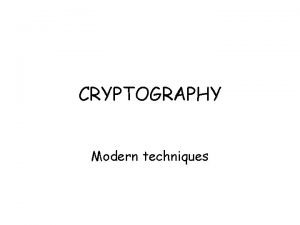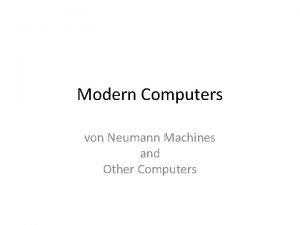Digital Computers and Information n Digital computers n























- Slides: 23

Digital Computers and Information n Digital computers n Number representations n Arithmetic operations n Alphanumeric codes Read MK 3 -26

What’s in a Computer? Graphics Card monitor keyboard microprocessor FPU MMU CPU Internal Cache Microprocessor • Central Processing Unit • Floating Point Unit • Memory Mgmt. Unit • Internal Cache Memory 1. 2 - Jon Turner - 12/26/2021 Network Interface Disk Controller Peripheral Bus Interface External Cache Main Memory • stores running programs and associated data • typically 64 -512 Mbytes • Dynamic RAM

What’s in a Computer? Graphics Card monitor keyboard microprocessor FPU MMU CPU Internal Cache External Cache • small, fast memory • stores recently used data 1. 3 - Jon Turner - 12/26/2021 Network Interface Disk Controller Peripheral Bus Interface External Cache Memory Bus Control movement of data between memory and I/O devices Main Memory

What’s in a Computer? Transfer data between Peripheral Bus Graphics Card monitor keyboard Convert text & graphics to video 1. 4 - Jon Turner - 12/26/2021 microprocessor FPU MMU CPU Internal cache Network Interface Peripheral Bus Interface External Cache external network & memory Disk Controller Read/write data on proper physical location on disk Main Memory

What’s in a Chip? Intel 80286 Microprocessor (www. micro. magnet. fsu. edu/chipshots) NEC/MIPS R 4400 Microprocessor (www. micro. magnet. fsu. edu/chipshots) n Photomicrographs made using colored filters. 1. 5 - Jon Turner - 12/26/2021

Basic Processor & Memory Processor PC 10 Instruction Decoder n Memory ACC Memory 50 Arithmetic & Logic Unit stores programs and data. Address read/write Address Decode Data » organized as set of numbered storage slots » each storage slot (memory word) can hold a number » processor can read from or write to any word n Fetch & execute cycle 0 1 2 3. . . ffff » read word whose address is in Program Counter (PC) and increment PC » interpret stored value as instruction (decoding) » perform instruction using Accumulator (ACC) and Arithmetic & Logic Unit (ALU) 1. 6 - Jon Turner - 12/26/2021 11 21 -3 65 56

Instruction Set 0000 halt - halt execution 0001 negate - ACC : = -ACC 1 xxx immediate load – if sign bit of xxx is 0 then ACC : = 0 xxx else ACC : = fxxx 2 xxx direct load - ACC : = M[0 xxx] 3 xxx indirect load - ACC : = M[M[0 xxx]] 4 xxx direct store - M[0 xxx] : = ACC 5 xxx indirect store – M[M[0 xxx]] : = ACC 6 xxx branch - PC : = 0 xxx 7 xxx branch if zero - if ACC = 0 then PC : = 0 xxx 8 xxx branch if positive - if ACC > 0 then PC : = 0 xxx 9 xxx branch if negative - if ACC < 0 then PC : = 0 xxx add - ACC : = ACC + M[0 xxx] 1. 7 - Jon Turner - 12/26/2021

Simple Program n Add the values in locations 20 -2 f and write sum in 10. Address Instruction Comment 0000 (start)1000 (ACC : = 0000) initialize sum 0001 4010 (M[0010] : = ACC) 0002 1020 (ACC : = 0020) initialize pointer 0003 4011 (M[0011] : = ACC) 0004 (loop) 1030 (ACC : = 0030) if pointer = 030, quit 0005 0001 (ACC : = -ACC) 0006 a 011 (ACC : =ACC+M[0011]) 0007 700 f (if 0 goto 000 f) 0008 3011 (M[M[0011]] : = ACC) sum = sum + *pointer 0009 a 010 (ACC : =ACC+M[0010]) 000 a 4010 (M[0010] : = ACC) 000 b 1001 (ACC : = 0001) pointer = pointer + 1 000 c a 011 (ACC : =ACC+M[0011]) 000 d 4011 (M[011] : = ACC) 000 e 6004 (goto 0004) goto loop 000 f (end) 0000 (halt) halt 0010 Store sum here 0011 Pointer to next value 1. 8 - Jon Turner - 12/26/2021

Representing Information in Computers n Electronic computers represent information as voltage levels. n To make the computer hardware simple and reliable, computers represent information in binary form. » example: voltages greater than 3 V are interpreted as representing one value (called “ 1”), voltages less than 2 V are interpreted as representing another value (called “ 0”). n In principle, could use more voltage levels. » example: 0 to. 75 V represents “ 0”, 1 to 1. 75 V represents “ 1”, 2 to 2. 75 V represents “ 2”, and so forth. n In practice, this is rarely done. » requires more complex circuits » circuits are more susceptible to noise, hence less reliable 1. 9 - Jon Turner - 12/26/2021

Noise in Computer Systems n Computers, like all electronic systems, are affected by noise. » noise has various sources (nearby signal changes, thermal vibrations of molecules in semiconductor materials, . . . ) » in computers, noise can cause binary signals to be misinterpreted n The noise margin is the amount of noise that a system can tolerate and still correctly identify a logic high or low. 5 v High 4 v High 3 v Undefined 2 v Undefined 1 v Low noise margin 3 V 1. 10 - Jon Turner - 12/26/2021 Low 0 v noise margin 1 V

Number Representation n Standard decimal number representation 243. 83 = 2´ 102 + 4´ 101 + 3´ 100 + 8´ 10 -1 + 3´ 10 -2 n Generalization to base r An. . . A 1 A 0. A-1. . . A-m =An´rn +. . . + A 1´r 1 +A 0´r 0 + A-1´r-1 +. . . + A-m´r-m n Binary number representation 110. 01 = 1´ 22 + 1´ 21 + 0´ 20 + 0´ 2 -1 + 1´ 2 -2 n Converting binary numbers to decimal (easy). write binary expansion, replace powers of 2 with decimal values, and add up the values 110. 01 = 1´ 22 + 1´ 21 + 0´ 20 + 0´ 2 -1 + 1´ 2 -2 = 4 + 2 + 1/4 = 6. 25 Note: it helps to know your powers of 2 (hint) 1. 11 - Jon Turner - 12/26/2021

Decimal-Binary Conversion n Repeated division by 2 625/2 = 312/2 = 156/2 = 78 78/2 = 39 39/2 = 19 19/2 = 9 9/2 = 4 4/2 = 2 2/2 = 1 1/2 = 0 with remainder of 1 with remainder of 0 with remainder of 1 with remainder of 0 with remainder of 1 least significant bit So, (625)10 = (10 0111 0001)2 n Works similarly for other number bases. 1. 12 - Jon Turner - 12/26/2021

Octal and Hexadecimal n Octal (base 8) and hexadecimal (base 16) provide more convenient way for people to write binary numbers. » 110101100010 = 110 101 100 010 = (6542)8 1101 0110 0010 = (d 62)16 octal conversion 000 = 0 001 = 1 010 = 2 011 = 3 100 = 4 101 = 5 110 = 6 111 = 7 1. 13 - Jon Turner - 12/26/2021 hexadecimal conversion 0000 = 0 1000 = 8 0001 = 1 1001 = 9 0010 = 2 1010 = a 0011 = 3 1011 = b 0100 = 4 1100 = 12 = c 0101 = 5 1101 = 13 = d 0110 = 6 1110 = 14 = e 0111 = 7 1111 = 15 = f

Finite Data Representations n Computer hardware is generally designed to operate on words with a fixed number of bits (e. g. 16 bits). n Places a limit on the number of discrete values that can be stored in a single word (e. g. 216). n If we use words to represent positive integers then with n bits, we can represent integers 0 up to 2 n-1 n Larger integers can be represented by multiple words. » computer hardware operates on single words » software must combine results from single word operations to produce desired result n Or, use floating point representation for large (and small) values; typically supported by computer hardware. 1. 14 - Jon Turner - 12/26/2021

How Computers Add n Binary long addition similar to decimal long addition. carry augend addend sum decimal 1100 2565 6754 9319 binary 111100 10110 11011 110001 n Binary addition algorithm - add an-1. . . a 0 to bn-1. . . b 0 and put result in sn. . . s 0 c 0=0 // ci are carry bits for i = 0 to n-1 if one or three of ai, bi or ci are = 1 then si = 1 else si = 0 if at least two of ai, bi or ci are = 1, then ci+1 = 1 else ci+1 = 0 sn = c n 1. 15 - Jon Turner - 12/26/2021

Modular and Signed Arithmetic n Computers 15 0 1 2 14 11 0 0 3 13 4 0100 12 50 11 1 10 6 10 9 8 7 10 10 01 10 1 0011+0110 =1001 110 1 11 -7 -8 7 10 01 10 -1 0 1 11 0 0 3 4 0100 50 101 6 2 10 01 1 011 1000 10 -2 -3 1100 -4 -5 1 1 -6 10 000 00 1 10 1111+0011=0010 n Associating 1. 16 - Jon Turner - 12/26/2021 0000 00 1 10 10 111 certain bit patterns with negative values yields signed arithmetic. n Negate a given value by flipping all bits and adding 1. n Must pay attention to overflow. 11 10 01 1 011 1000 » to add A+B, start at position for A and then count clockwise B positions » modular arithmetic is just like “clock arithmetic” 1111+0011=0010 1 111 use modular arithmetic in which values wrap around circularly.

Representing Text Computers use numbers to represent alphabetic characters, numerals and punctuation. n Most common encoding is ASCII (American Standard Code for Communication Interchange) n » characters represented by 7 bit values » numerals start at (30)16 » upper case letters start at (41)16 » lower case letters start at (61)16 » see Table 1 -4 in Mano for details n Unicode uses 16 bits per character, allowing it to represent far more distinct characters. 1. 17 - Jon Turner - 12/26/2021

Convert Numeric String to Internal Value n ASCII character codes for decimal integer stored in locations 20 -24 with M. S. D. at location 20. Write internal value in location 1 f. Address Instruction Comment 0000 (start)1000 (ACC : = 0000) result = 0 0001 401 f (M[001 f] : = ACC) 0002 1020 (ACC : = 0020) pointer = 020 0003 401 d (M[001 d] : = ACC) 0004 (loop)1025 (ACC : = 0025) if pointer = 025, quit 0005 0001 (ACC : = -ACC) 0006 a 01 d (ACC : = ACC + M[001 d]) 0007 7015 (if 0 goto 0015) 0008 100 a (ACC : = 000 a) result = 10 * result 0009 b 01 f (ACC : = ACC*M[001 f]) New multiply inst. 000 a 401 f (M[001 f] : = ACC) 1. 18 - Jon Turner - 12/26/2021

Convert Numeric String (continued) Address 000 b 000 c 000 d 000 e 000 f 0010 0011 0012 0013 0014 0015 (end). . 001 d 001 e 001 f 0020 Instruction Comment 1 fd 0 (ACC : = -30) result = result 401 e (M[001 e] : = ACC) + (*pointer-‘ 0’) 301 d (ACC : = M[M[001 d]]) a 01 e (ACC += ACC+M[001 e]) a 01 f (ACC += ACC+M[001 f]) 401 f (M[001 f] : = ACC) 1001 (ACC : = 0001) pointer = pointer + 1 a 01 d (ACC : = ACC+M[001 d]) 401 d (M[001 d] : = ACC) 6004 (goto 0004) goto loop 0000 (halt) halt 1. 19 - Jon Turner - 12/26/2021 Pointer to next char Temporary value Store result here ASCII digits

Convert Internal Value to Numeric String n Write ASCII character codes for value in location 1 f into words 20. . 24 with L. S. D. in word 20. loop pointer = 20 if pointer = 25 then quit *pointer = (value modulo 10) + ‘ 0’ value = value / 10 pointer = pointer + 1 goto loop n Exercise: write corresponding machine program; assume two new instructions cxxx dxxx 1. 20 - Jon Turner - 12/26/2021 divide value in accumulator by value in location xxx and leave quotient in accumulator divide by value in xxx & put remainder in ACC

Another Look at Basic Computer Address Bus PC IREG Controller n Program IAR ACC Data Bus ALU read/write 0000 0001 0002 0003 0004 0005 0006 0007 0008 0009 000 a Counter (PC) stores address of next. . . instruction. ffff n Instruction Register & Decoder (IREG) stores Memory current instruction. n Indirect Address Register (IAR) stores indirect addresses. n Accumulator (ACC) stores arithmetic operands and results. n Arithmetic & Logic Unit (ALU) implements arithmetic functions. n Controller coordinates actions of other components. n Data & Address Buses carry data between components. 1. 21 - Jon Turner - 12/26/2021

Execution of a Computer Program reset (initialization) monitored signals 1. 22 - Jon Turner - 12/26/2021 program counter, instruction register, accumulator, . . . system clock waveforms & buses time axis

Execution of a Computer Program reset period fetch first instruction 1. 23 - Jon Turner - 12/26/2021 execute first instruction mload fetch second instruction execute second instruction – dload
 Introduction to digital control system
Introduction to digital control system Classification of digital computer
Classification of digital computer Example of digital computers
Example of digital computers Site:slidetodoc.com
Site:slidetodoc.com Digital market and digital goods
Digital market and digital goods Computers make the world smaller and smarter
Computers make the world smaller and smarter Test chapter 12 computers and technology in health care
Test chapter 12 computers and technology in health care Impact of computers in today's society
Impact of computers in today's society Understanding computers today and tomorrow
Understanding computers today and tomorrow Control flow and data flow computers
Control flow and data flow computers Words related to computers
Words related to computers Chapter 1 introduction to computers and programming
Chapter 1 introduction to computers and programming Computers make the world smaller and smarter
Computers make the world smaller and smarter Chapter 1 introduction to computers and programming
Chapter 1 introduction to computers and programming Rsi ict
Rsi ict Chapter 1 introduction to computers and programming
Chapter 1 introduction to computers and programming C programming chapter 1
C programming chapter 1 Incomplete vs imperfect information
Incomplete vs imperfect information Digital services for information management
Digital services for information management Advanced digital information corporation
Advanced digital information corporation Management information system managing the digital firm
Management information system managing the digital firm Management information systems managing the digital firm
Management information systems managing the digital firm Introduction to information technology: your digital world
Introduction to information technology: your digital world Introduction to information technology: your digital world
Introduction to information technology: your digital world

